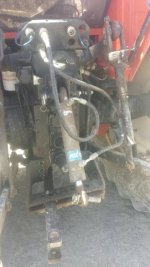I'll add to Pete's offerings.
A non-cancelling, non-float valve handle always springs back to center. There are no detents on either end of the handle stroke.
A self-cancelling valve handle has detents on both ends of the stroke. I use mine when pulling my hydraulic lift wheeled disc. To raise the disc, pull handle rearward into the detent, when the cylinder reaches the end of it's stroke it kicks back to center on it's own. To lower the disc, push handle forward into detent, when the cylinder reaches the end of it's stroke it kicks back to center on it's own.
A float valve handle has a detent in the forward position (lower position) only. This puts the valve into "float" position and as explained allows the cylinder to freely extend/collapse. Pull back on the handle from center and it acts spring loaded like the first valve I described.
I have one SCV and two float valves on my Kubota. The Ford has two SCV valves.
